Translations:AY Honors/Harmful Animals/Answer Key/48/en
Black rat (Rattus rattus)
Description: common long-tailed rodent of the genus Rattus (rats) in the subfamily Murinae (murine rodents). The species originated in tropical Asia and spread through the Near East in Roman times before reaching Europe by the 1st century and spreading with Europeans across the world. Black rats are generalist omnivores. They are serious pests in nature as they eat birds and insects, and to farmers as they eat a wide range of agricultural crops. They are vectors of many diseases including the bacterium Yersinia pestis, an agent of bubonic plague.
Habitat: everywhere they can get a foothold
Type of sexual reproduction: breed like other mammals
Eating habits: Black rats express great flexibility in their foraging behavior. They are predatory animals and adapt to different micro-habitats. They often meet and forage together in close proximity within and between sexes. Rats tend to forage after sunset. If the food cannot be eaten quickly, they will search for a place to carry and hoard to eat at a later time. Although black rats eat a broad range of foods, they are highly selective feeders; only a restricted number of the foods they eat are dominant foods. When black rat populations are presented with a wide diversity of foods, they eat only a small sample of each of the available foods. This allows them to monitor the quality of foods that are present year round, such as leaves, as well as seasonal foods, such as herbs and insects. This method of operating on a set of foraging standards ultimately determines the final composition of their meals. Also, by sampling the available food in an area, the rats maintain a dynamic food supply, balance their nutrient intake, and avoid intoxication by secondary compounds.
Diseases and harm to humans: when introduced to a new area, black rats often destroy native vegetation and can cause native species of other animals and birds to go extinct. Black rats are able to carry a number of pathogens, of which bubonic plague (via the rat flea), typhus, Weil's disease, toxoplasmosis and trichinosis are the best known. Rats also eat food stores and destroy other property.
Prevention: municipal sanitation and pest control measures are widely practiced to control the rat population. This includes poisons and traps. Pesticides are sprayed from planes when attempts are made to kill of rats on islands. When efforts are let up, the rat population often rebounds within months.
Coyote (canis latrans)
Description: the coyote is a canid native to North America. It is a smaller, more basal animal than its close relative, the gray wolf,[2] being roughly the North American equivalent to the old world golden jackal, though it is larger and more predatory in nature.
Habitat: widespread in North and Central America including rural and urban environments
Type of sexual reproduction: breed like other mammals, a type of dog
Eating habits: It has a varied diet consisting primarily of animal matter, including ungulates, lagomorphs, rodents, birds, reptiles, amphibians, fish and invertebrates, though it may also eat fruit and vegetable matter on occasion. Coyotes eat grass an grains as well.
Diseases and harm to humans: Coyotes target pets and are the leading cause of livestock losses in North America. Coyote attacks on humans are uncommon and rarely cause serious injuries, due to the relatively small size of the coyote, but have been increasingly frequent, especially in the state of California. In the 30 years leading up to March 2006, at least 160 attacks occurred in the United States, mostly in the Los Angeles County area.
Prevention: The US government authorized the killing of 90,000 coyotes to protect livestock in one recent year. Livestock dogs are often kept with sheep. Keeping pets contained and garbage contained reduces coyote problems.
harp seal (Pagophilus groenlandicus)
Description: The harp seal or saddleback seal is a species of earless seal native to the northernmost Atlantic Ocean and parts of the Arctic Ocean. The latin name means "ice-lover from Greenland"
Habitat: northernmost Atlantic Ocean and parts of the Arctic Ocean, often on ice flows
Type of sexual reproduction: breed like other mammals
Eating habits: seals eat fish
Diseases and harm to humans: seals are hunted for meat and fur, but the primary justification is that they eat a lot of fish that humans want to catch. The seal harvest is very controversial.
Prevention: Seals are hunted in Canada, Namibia, Greenland, Iceland, Norway and Russia, Finland and Sweden.



